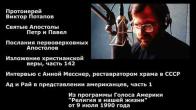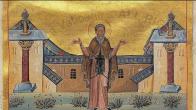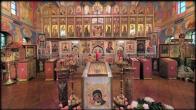You are here
January
- December 20/January 2 -- "Novodvorskaya", "Novgorod", "Rescuer of the Drowning"
- December 26/January 8 -- "Help in Birth-giving", "Helper in Birth", Bari Icon, known as "Blessed Womb", Kykkos
- December 29/January 11 -- "The Children Slain by Herod"
- January 12/25 -- "The Milk-Giver", "Akathist", "Popskaya"(Serb.)
Novodvorskaya Icon
20 December /2 January
According to tradition, the miraculous icon of the Theotokos known as the Novodvorskaya Icon was painted in the early 14th Century by the Holy Metropolitan St. Peter. Its name comes from the fact that when it was being painted, Holy Hierarch Peter was in a monastery, since destroyed, that stood on the bank of the River Rati, in the settlement Novy Dvorets [New Palace], in Volynh…
Currently, the Novodvorskaya Icon of the Mother of God is in the Holy Transfiguration Monastery in Novgorod-Seversk in the Diocese of Chernigov.
There is an especially revered copy of the Novodvorskaya Icon in the Kamenets Dormition Convent, Novozybkov District of Chernigov Province. The Convent was established in 1687 by Hieromonk Jonah Volkhovsky. Archbishop Lazar (Baranovitch) of Chernigov blessed the newly established Monastery with his own Novodvorskaya Icon of the Mother of God. At the request of the Hierarch, that icon had been copied from Holy Metropolitan St. Peter's icon. Currently, the Novodvorskaya Icon is considered the principal holy treasure of the Kamenets Convent. Multitudes of the faithful - not only from the local area and province, but also from other cities and towns - come together there to bow down before the Icon. God's grace, which rests upon the Kamenets Convent, has deigned to glorify the Novodvorskaya Icon with signs of Our Lady's special intercession and good will towards that Monastery.
On June 26, 1889, a great thunderstorm, with deafening peals of thunder and blinding flashes of lightning, descended upon the Kamenets Monastery. A lightning bolt struck the cupola of the Monastery's Dormition Church with particular force, immediately engulfing the tall pinnacle in flames. At the time, an Akathist was being served before the miraculous Novodvorskaya Icon. At the clap of thunder, everyone in church was stunned by an unusual sight: A burst of flame came down from the top of the church, descending along the chandelier chain, and then to the Icon of the Dormition of the Mother of God which hung over the Royal Doors. The force of the blow utterly shattered the Icon. From the Royal Doors, the lightning moved toward the Novodvorskaya Icon. The priest standing before the Icon was showered with fiery sparks, and the flames utterly consumed the Icon's cloth cover. And here it was that our Lady's particular benevolence toward her immaculate image was revealed: To everyone's surprise, the Icon was not harmed in any way, either by the strike or by the flames.
Then the lightning, as if repelled by some invisible force emanating from the Icon, turned to the massive, thick wall of the church, and rushed out of the church, with such force that after recovering from their shock, those present could see that the lightning had made an enormous hole in the wall. All the while, the fire in the cupola continued to burn. The convent's nuns, loudly weeping in helpless despair saw the fiery tragedy spread more and more. The cupola's great height prevented them from taking any measures to protect the church from the flames. However, Divine benevolence and Our Lady's Heavenly Protection saved the monastery from disaster. As if in response to the wave of some invisible hand, the wind fanning the flames subsided, a calm descended, and the fire gradually diminished, until it was completely extinguished. Everyone present saw in the marvelous events that had transpired a clear sign of intercession by the Most-holy Theotokos.
In commemoration of that event, there is a Procession of the Cross with the Novodvorskaya Icon of the Mother of God around the Kamenets Monastery annually on June 26, the third day after the Patronal Feast.
"Novgorod" Icon
20 December/2 January
The icon of the Mother of God known as the Novgorod Icon was painted by St. Peter, Metropolitan of All Russia, ca. 1320, while he was still in Volyn' in a monastery which is no longer in existence, which lay built on the Rati river, in a border settlement known as Novy Dvorets. During Uniate persecution of the Orthodox, when the Uniates attacked the Novgorod Monastery, the local hieromonk James (Iakov) took the icon to the Yeletsk monastery of the Dormition, in Chernigov. When the Surazh monastery was established near the town of Surazh, Bishop Antony Stakhovsky gave the icon to Symeon, builder of the monastery. The holy icon of the Novgorod Mother of God stood in the cathedral church of this monastery, which is no longer in existence. On August 14, 1677, the image was taken from the old church to the new one. St. Dimitry of Rostov, having come to venerate the miraculous icon at that time, reported that after the liturgy held in the church on August 16, Nicodemus, Bishop of Tselersk, told of the miracles which had flowed from the Image of the Mother of God.
"Rescuer of the Drowning" ("The Lenkovskaya Icon")
20 December / 2 January
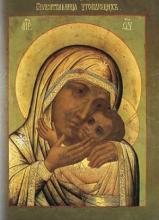 About 8.5 km. from the city of Novgorod of the North, in Chernigov District, lies the Village of Lenkovo, on the banks of the Desno. Long ago, the settlement was closer to the city. In it there was a church dedicated to the Synaxis of the Most-holy Theotokos, which is why the place is still known as “Bogoroditchniy,” i.e., belonging to the Theotokos. During the Polish incursion in the time of the pretender to the throne, the town of Lenkovo and its church were completely decimated. In the second half of the 17th Century the entire settlement was transferred to a new site. A new church, dedicated to the Holy Archangel Michael, was erected; it housed the miraculous Icon of the Mother of God.
About 8.5 km. from the city of Novgorod of the North, in Chernigov District, lies the Village of Lenkovo, on the banks of the Desno. Long ago, the settlement was closer to the city. In it there was a church dedicated to the Synaxis of the Most-holy Theotokos, which is why the place is still known as “Bogoroditchniy,” i.e., belonging to the Theotokos. During the Polish incursion in the time of the pretender to the throne, the town of Lenkovo and its church were completely decimated. In the second half of the 17th Century the entire settlement was transferred to a new site. A new church, dedicated to the Holy Archangel Michael, was erected; it housed the miraculous Icon of the Mother of God.
According to tradition, the Icon of the Mother of God was brought to this church from the former Church of the Theotokos. The historical account of its appearance and glorification relates the following.
In the river Desno, directly across from the hill on which the church was later built, there is an extremely dangerous whirlpool which even the most experienced sailors found difficult to traverse. Quite often, enormous barges loaded down with grain would become victims of the abyss: the powerful swirling waters would carry them and their passengers away. It was at that dangerous site that the Icon of the Mother of God came to rest on the riverbank and was found. The pious believers, who discovered the Most-immaculate Icon, installed it on a site facing the disastrous place. Some time later, the above-mentioned Church of the Theotokos came into being on that site. Ever since then, those plying the Desno River have made it their usual practice to stop at the Village of Lenkovo, go ashore and enter the church. After fervent prayer before the Icon of the Mother of God, they would cast lots to see who would remain on board the barge and steer it across the dangerous whirlpool. Their companions would continue on foot along the shore to pass the awful place. Evidently, the good will of the Mother of God rested on that dangerous site ever since the nearby church in her name was erected. It was noted that from the time of the appearance of the Icon of the Mother of God, mishaps to sailors there became a rarity, and later completely ceased.
In the 18th Century, the Icon was transferred to the Monastery of the Savior’s Transfiguration, where it remained until the October Revolution of 1917. History does not record what happened to the Miraculous Icon thereafter.
The Icon of the Most-immaculate Lady was greatly revered by the populace in the area of Lenkovo, and drew a multitude of faithful, especially those who often had to endure the perils of the waters, to pray before it.
The “Rescuer of the Drowning” Icon of the Mother of God, which was famous for many other miracles, came to be revered not only in area of Chernigov-Severschino, but far beyond, especially in large port cities of the Russian land.
On May 22, 2003, the feast day of Holy Hierarch St. Nicholas the Wonderworker, the Church of the “Unexpected Joy” Icon of the Mother of God, metochion of the Novgorod of the North Monastery of the Transfiguration of the Savior, was consecrated. After the consecration, Sergei Viatcheslavovitch Babushkin, a pious Christian, gave the rector of the monastery an antique exact copy of the Lenkovo Icon of the Mother of God.
The restored antique copy of the Miraculous “Rescuer of the Drowning” Icon once again returned to the land of Novgorod of the North, to the Monastery of the Transfiguration of the Savior. It was with the return of the Icon that the revival of the monastery began.
The "Help in Birth-giving" Icon
26 December / 8 January
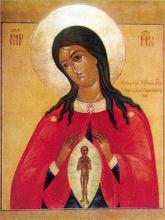 From time immemorial, it has been known that in moments of the most intense suffering of the birthing process, women run with especially fervent prayer to the Savior and to His Most-pure Mother. In our time as well, pious families keep copies of the Icon of the Mother of God known as the “Help in Birth-giving” Icon. In this Icon, the Most-pure Virgin is depicted full-length, standing with hands upraised, and with the Babe in her arms, as in the “Sign” Icon. Mothers bow down before this Icon, calling in fervent prayer upon the assistance of the Most-blessed Virgin Mary, the one who had painlessly given birth to Christ the Savior. They call out to her in a mother’s awesome, uniquely mysterious and secret moment, in the belief that she is a strong intercessor and helper before God for all who suffer and are heavy-laden. And who, running to the Queen of Heaven, can come away without being comforted by her in times of sorrow and ills?! Her almighty intercession brings a solution to all the illnesses and sufferings from which no earthly power or earthly riches could save us.
From time immemorial, it has been known that in moments of the most intense suffering of the birthing process, women run with especially fervent prayer to the Savior and to His Most-pure Mother. In our time as well, pious families keep copies of the Icon of the Mother of God known as the “Help in Birth-giving” Icon. In this Icon, the Most-pure Virgin is depicted full-length, standing with hands upraised, and with the Babe in her arms, as in the “Sign” Icon. Mothers bow down before this Icon, calling in fervent prayer upon the assistance of the Most-blessed Virgin Mary, the one who had painlessly given birth to Christ the Savior. They call out to her in a mother’s awesome, uniquely mysterious and secret moment, in the belief that she is a strong intercessor and helper before God for all who suffer and are heavy-laden. And who, running to the Queen of Heaven, can come away without being comforted by her in times of sorrow and ills?! Her almighty intercession brings a solution to all the illnesses and sufferings from which no earthly power or earthly riches could save us.
There is another very ancient Icon, known as the “Icon of the Most-holy Theotokos, helper to women giving birth to children.” On that Icon, the Mother of God is depicted with head uncovered, her hair flowing down her shoulders, and her arms folded upon her breast. The fingers of the left hand partially cover the fingers of the right. Below the level of her wrists sits the Divine Infant, the fingers of His right hand forming the acronym of His Name (ICXC), and the left resting upon His knee. His feet protrude from below the hem of his garments. The Theotokos’ outer garment is red and gold, with a gold star on each shoulder. Her inner garment is dark green, with flashes of gold and with gold stars, and the same kind of trim on her collar and cuffs. The Theotokos’ head inclines slightly. The Savior’s clothing is yellow and gold, blending on his chest into a dark green color. The entire composition is written on a semi-circle.
The Miraculous Icon “Helper in Childbirth“"
December 26/January 8
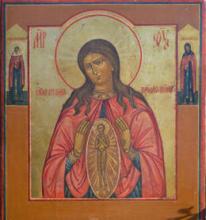 The Helper in Childbirth (also known as: Help in Labor, Assister in Birthing, Helper to Women in Giving Birth to Children) is a widely-venerated Icon of the Mother of God. Usually, expectant mothers come to it who ask to be sent a successful delivery. However, turning to this icon may also help those unable to bear children, as many formerly barren women who have personally experienced its holy power attest.
The Helper in Childbirth (also known as: Help in Labor, Assister in Birthing, Helper to Women in Giving Birth to Children) is a widely-venerated Icon of the Mother of God. Usually, expectant mothers come to it who ask to be sent a successful delivery. However, turning to this icon may also help those unable to bear children, as many formerly barren women who have personally experienced its holy power attest.
The Icon’s history is shrouded in the darkness of ages past. Likewise, where the original Icon first appeared is unknown.
From time immemorial, birth-giving, which is attended by physical travails, and barrenness, which is attended by spiritual travails, have moved women to run to the Holy Icon of the Mother of God with a plea for her help and intercession before the Lord. Probably, the appearance of Icons depicting the Mother of God bearing and bringing forth the Infant Jesus is related to that fact.
The Icon of the Most-holy Theotokos, Helper in Childbirth, is of this type.
There are two canonical versions of the Icon:
In the first version is a full-length depiction of the Theotokos standing with arms upraised in prayer, with the Infant Jesus at the level of her breast.
In the second version, the Mother of God is depicted with her head uncovered and her hair spread loose and not tied back. Her outer garments are red, with a play of glimmering gold, and with little gold stars on her shoulders (the stars are not present on all of the icons). Her inner garment is dark green, also accented with gold. The hands of the Theotokos are folded over her chest. The fingers of the left hand are partially covered by the fingers of the right.
The Infant Jesus is depicted under the folded hands. The fingers of His right hand form the sign of blessing (each finger represents a letter of the Greek alphabet – the index finger extended into an I [iota], the middle finger to form a C [sigma], the thumb crossed over the ring finger to form a X [chi], and the little finger bent to form a C. This results in IC XC, the monogram of Jesus Christ.
The Bari Icon of the Mother of God, known as the «Blessed Womb»
26 December / 8 January
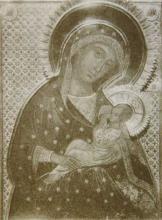 This unusual icon was brought to Moscow from the Italian city of Bari on December 26, 1392. The icon, which formerly stood near the reliquary containing the relics of Holy Hierarch St. Nicholas, became the patronal holy icon of the Great Prince's family, and was installed in the Annunciation Cathedral in the Moscow Kremlin. Out of the multitude of holy treasures in that Cathedral, the Bari Icon was particularly venerated. It was set in a very expensive and precious frame, and was extensively copied.
This unusual icon was brought to Moscow from the Italian city of Bari on December 26, 1392. The icon, which formerly stood near the reliquary containing the relics of Holy Hierarch St. Nicholas, became the patronal holy icon of the Great Prince's family, and was installed in the Annunciation Cathedral in the Moscow Kremlin. Out of the multitude of holy treasures in that Cathedral, the Bari Icon was particularly venerated. It was set in a very expensive and precious frame, and was extensively copied.
The last time an inventory of the Cathedral mentioned the Icon was in 1923; its fate since then is unknown. Currently, one of the copies of the Bari Icon of the Mother of God rests in the Annunciation Cathedral.
The Kykkos Icon of the Mother of God
26 December/8 January
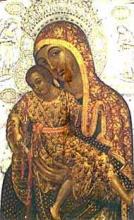 According to tradition, this Icon was written by the Holy Evangelist St. Luke. It was named «Kykkotissa» after Mt. Kykkos, on the Isle of Cyprus. There it may be found in the imperial monastery, in a church dedicated in its honor. It was God's will that before coming to rest in Cyprus, this Miraculous Icon of the Theotokos should travel a great deal: at first, it was in the keeping of one of the earliest Christian communities in Egypt, then was taken to Constantinople, where it remained until the reign of Alexios Komnenos (late 11th to early 12th Century). During this period, it was revealed in a miraculous vision to the Hermit-Elder Isaiah that through his efforts, the miraculous Icon made by St. Luke the Evangelist would stay on the Isle of Cyprus. The Elder expended a great deal of effort in keeping with that Divine revelation. With the arrival of the Icon of the Mother of God on the island, a host of miracles began to flow from the Icon. From times of old, and to this day, from all over the world, multitudes of people afflicted with all manner of illnesses come to the monastery and receive healing according to their faith. It is not only Christians, but people of other faiths, that believe in the Holy Icon's miraculous power, and rush to it in times of trouble and disease. Inexhaustible is the kindness and mercy of the Most-holy Theotokos, intercessor for all who suffer, and truly fitting is the Icon's name, «Merciful One.» One feature of the Miraculous Kykkos Icon of the Mother of God that is worthy of note, is that from some time in the past, it has been partially covered by a cloth, extending from the upper left corner to the lower right, so that no one may see, and no one dares to look upon, the faces of the Mother of God and the Divine Infant. The depiction of the Mother of God on the Icon is of the Hodigitria type, like the Smolensk Icon of the Mother of God. The Theotokos has a crown upon her head.
According to tradition, this Icon was written by the Holy Evangelist St. Luke. It was named «Kykkotissa» after Mt. Kykkos, on the Isle of Cyprus. There it may be found in the imperial monastery, in a church dedicated in its honor. It was God's will that before coming to rest in Cyprus, this Miraculous Icon of the Theotokos should travel a great deal: at first, it was in the keeping of one of the earliest Christian communities in Egypt, then was taken to Constantinople, where it remained until the reign of Alexios Komnenos (late 11th to early 12th Century). During this period, it was revealed in a miraculous vision to the Hermit-Elder Isaiah that through his efforts, the miraculous Icon made by St. Luke the Evangelist would stay on the Isle of Cyprus. The Elder expended a great deal of effort in keeping with that Divine revelation. With the arrival of the Icon of the Mother of God on the island, a host of miracles began to flow from the Icon. From times of old, and to this day, from all over the world, multitudes of people afflicted with all manner of illnesses come to the monastery and receive healing according to their faith. It is not only Christians, but people of other faiths, that believe in the Holy Icon's miraculous power, and rush to it in times of trouble and disease. Inexhaustible is the kindness and mercy of the Most-holy Theotokos, intercessor for all who suffer, and truly fitting is the Icon's name, «Merciful One.» One feature of the Miraculous Kykkos Icon of the Mother of God that is worthy of note, is that from some time in the past, it has been partially covered by a cloth, extending from the upper left corner to the lower right, so that no one may see, and no one dares to look upon, the faces of the Mother of God and the Divine Infant. The depiction of the Mother of God on the Icon is of the Hodigitria type, like the Smolensk Icon of the Mother of God. The Theotokos has a crown upon her head.
The Icon "The Children Slain by Herod"
29 December / 11 January
Until the Revolution of 1917, there was in the St. Elias Church in Vologda, an ancient icon, remarkable both for the delicacy of its execution and for its title as recorded in the Church inventory of 1809. It was described as the : “Icon of the Mother of God – the Children Slain by Herod.” It depicted the Mother of God and the Divine Infant in the clouds, surrounded by a wreath consisting of many naked infants, arrayed in a wide variety of positions.
The body of one of the infants slain in Bethlehem rests in the Kiev cave of St. Theodosius. Barren women turn to this infant martyr for help in making them able to bear children. Prayers for the health of children are also offered up to him.
The relics of the infant slain at Herod’s direction, were brought to Kiev in 1620 by Patriarch Theophanes of Jerusalem; they rest in a silver reliquary. It is not known why he is known as John.
The "Milk-Giver" Icon
12/25 January
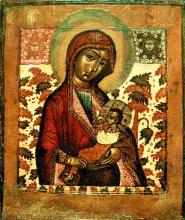 The icon of the Mother of God called the "MilkGiver" is found at the present time on Athos, in the church of the Karyes kellion belonging to the Serbian Monastery of Hilandar. Oral tradition, preserved till now in this monastery, states that initially this icon was found in the Lavra of Saint Sabbas the Sanctified, which is situated not far from Jerusalem.
The icon of the Mother of God called the "MilkGiver" is found at the present time on Athos, in the church of the Karyes kellion belonging to the Serbian Monastery of Hilandar. Oral tradition, preserved till now in this monastery, states that initially this icon was found in the Lavra of Saint Sabbas the Sanctified, which is situated not far from Jerusalem.
Before his blessed end, Saint Sabbas the Sanctified, the great founder of the only lavra in the East, turned to the brethren surrounding his deathbed and prophetically stated that in time a pilgrim of royal lineage from Serbia, having the same name as he, that is, named Sabbas, would visit the Monastery, and to him the Icon of the Mother of God, the "MilkGiver", should be given as a blessing from the Monastery. Saint Sabbas the Sanctified peacefully departed to the Lord in the year 532. After the death of the Venerable one, more than six centuries rushed by at the Palestinian monastery founded by him. The icon of the Theotokos called the "MilkGiver" stood immovably in its place, awaiting the fulfillment of the prophetic deathbed testament of Saint Sabbas, which was passed down in his monastery by oral tradition from century to century. The fulfillment of the predictions ensued only in the 13th century, when Saint Sabbas [or Savva], the Archbishop of Serbia, actually arrived in Palestine. The prophetic testament of Saint Sabbas the Sanctified was related to him and the icon of the divine "MilkGiver" was handed to him together with another icon of the Mother of God, the socalled "Threehanded" Icon.
On the return trip from Palestine to Serbia, Saint Savva visited Mount Athos, where the Hilandar Monastery had been founded by him. And to this his Monastery, he left the icon of the Most Holy Theotokos, the "MilkGiver", as an inalienable legacy and finest adornment, having placed it in the church at the Karyes kellion belonging to Hilandar, which was subsequently called Typicarnitsa, since in it the Typicon (Rule) written by Saint Savva was preserved. The other icon, the "Threehanded" one, he took with him to Serbia. This was on the first journey of Saint Savva of Serbia to Palestine. A circumstance which involuntarily draws attention to itself is the fact that the icon of the "MilkGiver", contrary to the general practice of our Eastern Church, was placed by Saint Savva of Serbia, and remains till now, on the iconostasis not at the left side of the Royal Gates, but at the right side, where an icon of either the Holy Trinity or the Saviour is usually placed. The image of the Lord Almighty occupies that place on the left side of the Royal Gates in this church were the icon of the Mother of God strictly ought to stand.
The depiction of the face of the Mother of God and her Divine Son on the icon of the "MilkGiver" is expressive, beautiful and in a strict Church style. One may easily number this icon among the best images of the Byzantine school.
There is one more icon of the Mother of God that bears the name of the "MilkGiver". It is found in the Russian Scete of Saint Elias on Athos, and belongs to the number of the locally venerated icons. In 1992, by order of the Ecumenical Patriarch, the monks of this scete were expelled, and many valuables of the monastery were looted. At the present time, the fate of the locally venerated icon of the "MilkGiver" in the Scete of Saint Elias is not known to us.
The "Akathist" Icons
12 / 25 January
The Akathist Icon of the Mother of God is in the icon screen of the Chilandar Cathedral Church. It became known as the "Akathist" Icon because in 1837, during a fire burning in the church, an akathist hymn was read before it, and as a consolation to the monks, the icon remained unscathed.
The "Popskaya" Icon
12/25 January
The “Popskaya” Icon of the Mother of God is at the column at the left kliros in the cathedral of the Serbian Chilandar Monastery on Holy Mt. Athos. At one time, a heretic priest who called himself Orthodox entered the Chilandar Monastery with evil intent and was punished for it. While carrying this Icon during a Procession of the Cross and Blessing of the Waters, he stumbled, fell into the sea, and drowned. Since then, all Processions of the Cross have been with this Icon. Because only a priest [a “pop”] may carry the Icon, the Serbs refer to it as the “Popskaya” Icon.
PARISH LIFE
RECENT VIDEOS
Address of our Cathedral
Subscribe to our mailing list
While all the materials on this site are copyrighted, you may use them freely as long as you treat them
with respect and provide attribution on the Russian Orthodox Cathedral of St.John the Baptist of Washington DC.



